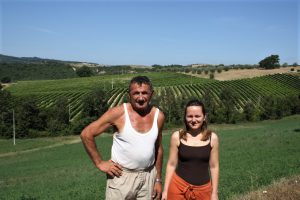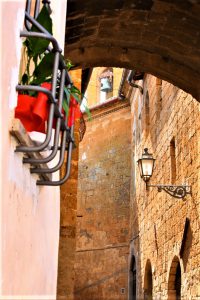( First appeared in The Economic Times, March 16, 2012)
The historic Palazzo del Gusto in the hill town of Orvieto near Rome is an apt setting for the International Headquarters of CITTASLOW INTERNATIONAL and its director, the-smiling- with- his- eyes Pier Giorgio Oliveti, who sports a prophet’s wispy beard, the right messiah for the cause. Cittaslow, meaning slow city, is the antithesis of the fast culture increasingly pervading modern life. It is a counter philosophy, expressed through a different lifestyle and attitude to life. If war and peace were the black and white of hippie perception, globalisation and homogenisation are the enemies of Cittaslow that seeks to protect things natural and distinctly local.

 There has been growing but mostly dormant discontentment with efficiency-centric and mechanical human activities made fashionable by the Industrial Revolution. As perpetrators of homogeneity, MNCs have always been perceived as villains of the globalisation piece. Some of this discontentment found expression in 1986, when MacDonald planned their first outlet in Italy, near the historic Spanish Steps in Rome. Locals saw this as a cultural invasion, threatening the local biodiversity, food habits and way of life. Following protracted protests and negotiations, MacDonald opened for business but missing from the brand display even today is the familiar red and yellow. Meanwhile, the spirit of the protest consolidated as the slow movement, claiming a membership of 100,000 in over 130 countries.
There has been growing but mostly dormant discontentment with efficiency-centric and mechanical human activities made fashionable by the Industrial Revolution. As perpetrators of homogeneity, MNCs have always been perceived as villains of the globalisation piece. Some of this discontentment found expression in 1986, when MacDonald planned their first outlet in Italy, near the historic Spanish Steps in Rome. Locals saw this as a cultural invasion, threatening the local biodiversity, food habits and way of life. Following protracted protests and negotiations, MacDonald opened for business but missing from the brand display even today is the familiar red and yellow. Meanwhile, the spirit of the protest consolidated as the slow movement, claiming a membership of 100,000 in over 130 countries.
A third of them are in Italy where the movement is known as Cittaslow, with slow agriculture (and the almost interchangeable slow food) the most active branch. In the fertile outskirts of Orvieto are farmlands the Government gifted to locals after their Israeli owners migrated to the Promised Land. These are showpieces of slow agriculture. The farmers use modern farm equipment to increase productivity, but what defines slow agriculture is the emphasis on local varieties, and local markets. Firstly, they have resisted monoculture followed by American farms and even in parts of Italy, notably in Po valley and in the Puglia region. Consciously protecting biodiversity, these farmers preserve and use local seeds.
Arks of Taste
The idea is to create and protect an ‘Ark of Taste’ for each bioregion. The strength of the movement flows from the Convivia or local chapters and the members. Praesidia is a special economical project of slow food that employs thousands of farmers who produce unique, traditional food, often low quantity high quality, for local markets and mass consumption institutions. This is promoted through farmer markets called “Mercati della Terra” in the Cittaslow squares and villages, and at supermarkets, through ‘slow corners’. With some sweet results, as Oliveti points out: “Italy grows 196 different species of local grapes and over 600 varieties of DOC wines. We also produce about 410 different kinds of cheeses”. Eco-friendly, and lots of jet miles saved, but how does this help the farmer? The locally used seeds, Olivetti argues, are the outcome of natural matchmaking over centuries, best suited to each territory and its soil. It is proven and sustainable. The consumer is spared transportation cost and delays, and he buys from a known source, enjoying seasonal variety.
 With a 26 hector land, Angelo is, in Italian terms, a medium-size farmer. (Italy’s average cultivated land is 7.9 hectares per farmer). Farmers have to pay for electricity and water, Angelo tells me, correcting the general Indian impression. He grows olive and grapes; he also rears 17 cows. It is hard labour which shows on his suntanned face and a Hercules-like body chiselled by 13 hours of work every day. He sells milk at 0.38 Euros a litre though the ultimate customer pays 1.40 Euros. (That sounds familiar, doesn’t it?). Is he better off now? He is not so sure. Angelo’s problem exemplifies the heterogeneous compound called the European Common market. The European Common Agriculture Policy, influenced by the large milk producing countries of France and Germany, is loaded against small and medium-size farmers, points out Oliveti. Slow food’s solution is to encourage Italian farmers to produce local cheese and create a market for it. Olivetti is also intent on advocacy to insert in the new agricultural policy for the next decade, the “greening” concept. “Each farm will be obliged to respect the ecological principles, to save soil, water, plants, etc.”
With a 26 hector land, Angelo is, in Italian terms, a medium-size farmer. (Italy’s average cultivated land is 7.9 hectares per farmer). Farmers have to pay for electricity and water, Angelo tells me, correcting the general Indian impression. He grows olive and grapes; he also rears 17 cows. It is hard labour which shows on his suntanned face and a Hercules-like body chiselled by 13 hours of work every day. He sells milk at 0.38 Euros a litre though the ultimate customer pays 1.40 Euros. (That sounds familiar, doesn’t it?). Is he better off now? He is not so sure. Angelo’s problem exemplifies the heterogeneous compound called the European Common market. The European Common Agriculture Policy, influenced by the large milk producing countries of France and Germany, is loaded against small and medium-size farmers, points out Oliveti. Slow food’s solution is to encourage Italian farmers to produce local cheese and create a market for it. Olivetti is also intent on advocacy to insert in the new agricultural policy for the next decade, the “greening” concept. “Each farm will be obliged to respect the ecological principles, to save soil, water, plants, etc.”
Slow life, anyone?
Though the movement has taken economic forms, the underlying argument is human, almost spiritual – and unexceptional. Prof. Guttorm Fløistad, one of the ideologues, urges people to get off the ever accelerating treadmill of life. As he notes, the basic human needs remain unchanged. “The need to be seen and appreciated.. the need to belong. The need for nearness and care, and for a little love!” All of which requires “slowness in human relations”, he argues. “In order to master changes, we have to recover slowness, reflection and togetherness.”
The quest to rediscover the unhurried way of life has shaped many facets of the generic idea. Slow food is the opposite of fast food. Slow parenting is the antithesis of helicopter parenting and it urges parents to let the children enjoy their childhood. Slow travel is the reaction to modern travel, performed at breakneck speed to maximise visiting points, in the process missing the experience of leisurely covering places, mingling with local people and imbibing local customs. Ecotourism is its close cousin. Slow gardening? You’ve guessed it right. Then there is slow economy and slow money. The idea is simple: invest in and patronise local growers and enterprises, so that money does not ‘leak out’ of the community, except as some inevitable taxes. There is also the (virtual) International Institute of Not Doing Much which uses humour and storytelling to fight ‘time poverty’ and workaholism. Clearly mocking at Microsoft’s “Do more, faster” proposition, it exhorts everyone to “Do less, slow”.

 All these counter themes coalesce to form the slow movement. Not all members are part of all the parallel themes. Instead, each selects from the buffet, based on personal relevance. Not unexpectedly, the movement’s forays are into countries marked by high economic growth – and the by-products of the consumption-centric modern life including obesity. The slow movement, like effective Communism, can serve to soften the brute force of MNC invasions and then to soothen the nerves and the bruises they inflict. Time is ripe for an India entry, I propose. With global salaries and higher disposable income, more people are seeking work-life balance, early retirement and ‘downshifting’ – bartering income for inner peace. Besides, India always had a non-materialistic streak, with ‘mindfulness’ and relaxed alertness familiar concepts. Oliveti knows that. He has visited India, is in touch with like-minded organisations (Navdanya was mentioned). When India is ready, it will happen, he says. But he would not force or accelerate it.
All these counter themes coalesce to form the slow movement. Not all members are part of all the parallel themes. Instead, each selects from the buffet, based on personal relevance. Not unexpectedly, the movement’s forays are into countries marked by high economic growth – and the by-products of the consumption-centric modern life including obesity. The slow movement, like effective Communism, can serve to soften the brute force of MNC invasions and then to soothen the nerves and the bruises they inflict. Time is ripe for an India entry, I propose. With global salaries and higher disposable income, more people are seeking work-life balance, early retirement and ‘downshifting’ – bartering income for inner peace. Besides, India always had a non-materialistic streak, with ‘mindfulness’ and relaxed alertness familiar concepts. Oliveti knows that. He has visited India, is in touch with like-minded organisations (Navdanya was mentioned). When India is ready, it will happen, he says. But he would not force or accelerate it.
Remember, it is the slow movement!

